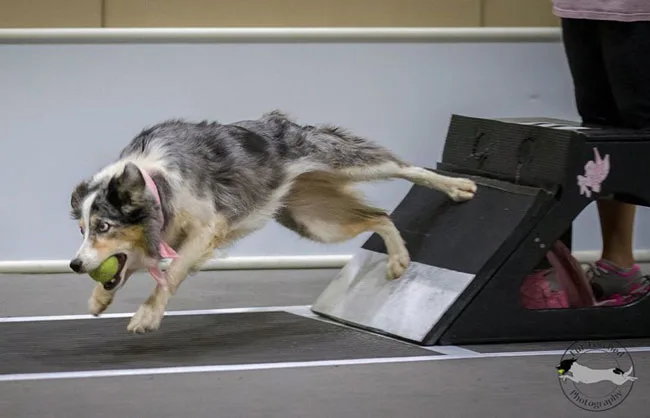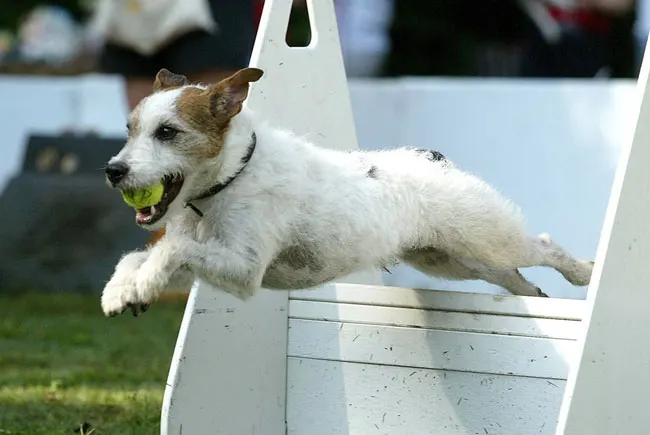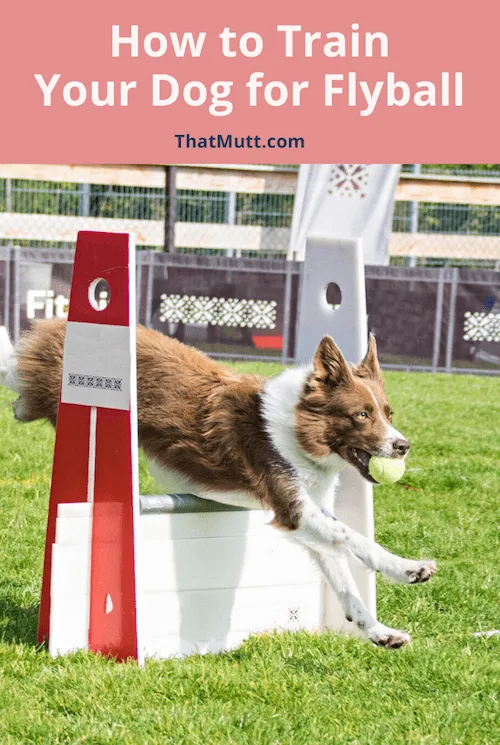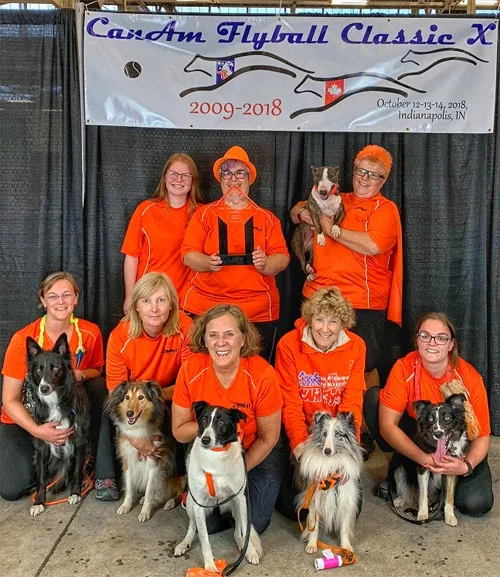Have you ever tried hurdles? Running along a track and leaping over a standing bar every few strides?
I remember a few hurdles attempts from high school gym class. I wanted to be graceful and coordinated and fast. Every so often I’d find the rhythm, but mostly it was just all-round awkward.
Watching dogs at flyball, I am not at all nostalgic for my high school hurdle days. I’ll happily let the dogs do it from now on.
I’m back today with another installment in our series about dog sports.
Today’s topic is flyball!
What is flyball?
Flyball is like the fastest game of fetch with hurdles thrown in for fun.
A dog sprints down a straight track, jumping over four hurdles. At the end of the track, the dog picks up a ball from a special dispenser called a flyball box, turns around and races back down the track, jumping the hurdles again.
Here is a video that shows the sport:
Dogs race in teams of four with the next dog starting as soon as the previous dog crosses the line. Two teams run at a time, so each dog is competing against another on parallel tracks.
Zoom! Flyball in Hamilton, Ontario
For Paula Johnson, the team aspect is her favourite part of flyball.
“We have so much fun as a team and love spending weekends together with our dogs and other teams,” she says.
“You can see the excitement the sport generates and how much people just love the thrill of racing with their dogs.”
Paula, along with her wife, Kim Fountain, is captain of Zoom! Flyball in Hamilton, Ontario. She is also a judge with the North American Flyball Association. While she’s a dedicated flyball competitor now, that was not always the case.
“I had long been involved in dog sports – agility, obedience, tracking, conformation – and was recruited by a friend to try out flyball. I was reluctant at first. After all I had a mini-bull terrier – not the most obvious flyball dog. Turns out, both her and I loved the sport and the rest is history.”
Best dog breeds for flyball
While fast dogs like border collies, whippets and sport mixes are the most obvious choices for flyball, any dog can play.
The Zoom! Flyball team is made up of dogs of all shapes, sizes and breeds. As long as dogs are physically fit and enjoy the game, they can play.
Here is a video of the sport from Zoom! Flyball!:
Dogs participating in flyball should be proper weight, with good muscle tone and a regular exercise regimen to make sure they can handle running sprints over and over again.
Paula says, “We treat our dogs like athletes and make sure they get chiropractic care, massage, proper warm up and cool down protocols. We want them to be in good shape to avoid injuries and give them a long life at playing this sport.”
The most important factor is for dogs to have a good retrieve and connection with their owner.
“Most people think that if they have a dog that loves balls that flyball is the obvious choice. But to be honest, the ball is just a small part of the game,” explains Paula.
“Dogs need to want to come back to the handler for whatever reward they use – food, tug toy, frisbee. If they are only obsessed with the ball it can actually be a problem to fix in training.”
How to train a dog to play flyball
As with any dog sport, you can’t force a dog to play flyball. All training is done with positive methods. Paula says that training could take at least a year from beginning to being ready to race. Depending on the dog it could take longer.
The first step is to build that drive in your dog to make them want to return to you. Then, it’s about preparing for the technical aspects of flyball.
Since a flyball course is out and back, a strong and proper “swimmers turn” is important.
The technique starts with teaching dogs to push off a slanted board or even a wall until the movement becomes part of their muscle memory. Then the action is transferred to an actual flyball box.
The final step is adding the ball and teaching the dogs to get the ball out of the box.

Learning to jump the hurdles
The hurdles are another element.
“Learning to take the hurdles on the way down and the way back is another piece of the puzzle we train separately at first,” says Paula.
“We want proper striding over the jumps to maximize the dog’s speed.” Training starts with one jump and then progresses to the full set of four.
Once all the pieces are in place, then the dog can try a full run.
But training isn’t done yet.
The distraction of other dogs
Learning to run with other dogs is a big factor in flyball. Again, training builds slowly from a stationary dog in the hall to a dog standing in the lane next to them to a dog in motion and so on until the dog can be successful. Then the training starts again with teaching the dog to pass another dog in its own lane.
This was a particular challenge for Paula’s dog, Jet, “She is a terrier, and the prey/chase drive was very high. Although she learned the mechanics of flyball very quickly, it took a long time to teach her not to chase the dog in the other lane.”
Now almost 10 years later Jet is a veteran and helps to train new members to the team.
All training is slow, and Paula emphasizes that it is important to build on success with each new challenge.
How to get involved in flyball
With four dogs running every race, flyball is most definitely a team sport for both the humans and the dogs. Each team can have a total of six dogs, which allows for back-ups in case of injury, training new dogs or resting older dogs.

Paula says that everyone has a part to play in the success of a team, from training to all the different jobs that have to be done at a tournament. If you’re considering flyball, it’s important that you want to be part of a team environment.
At the CanAm Flyball championships in Indianapolis, one of Paula’s teammates suffered a stroke and required emergency brain surgery (she has fully recovered).
“It was scary and the team was trying to hold it all together. We found out quickly how supportive a family the flyball community really is – people we didn’t know were coming up to us and asking how they could help. It was overwhelming, but it speaks to what is at the heart of this sport: community.”
Between training, practicing and tournaments, it takes commitment to play flyball. Like many sports, tournaments may take time and travel. Zoom! has traveled to tournaments in the US, Nova Scotia and this year are heading to PEI.

If you’re interested in trying flyball, the North American Flyball Association can be a good place to start. The Association offers a blog and a list of all the teams across North America.
“Find a team close to you and contact them to see if they are holding classes or taking on new members. Tournaments are also listed on that site by region, so see if there is one coming up and just go watch. People are always happy to talk about the sport they love,” Paula advises.
Competing with your dog
Paula’s most memorable experience in flyball was when Zoom! Flyball won its division at the CanAm Flyball Championships in 2018.
“We had worked so hard as a team and this was the icing on the cake. The best part was all of the people around the rings watching and cheering us on. We might not be the fastest team out there, but it doesn’t matter.”

While the current world record is just over 14 seconds, Paula explains that times are typically between 15 and 22 seconds.
Teams race against others with similar seed times (the fastest time your team of four dogs can run) so you can always be competitive within your division.
“That is what makes this sport so great – you don’t have to aspire to be the top team in the world,” she says.
The team captain is responsible for entering tournaments, which are usually posted on the NAFA website. The entry application includes your seed time which ensures you are put into the right division.
Watching dogs race in flyball, I can’t help but smile. Their enthusiasm is obvious—and their skill is impressive. Much better than my hapless hurdle attempts.
Paula concurs, “These dogs go simply crazy when they get near the lanes and will do it over and over again all weekend. Most of the dogs race for years during their lifetime and never lose their enthusiasm for the sport.”
Have you ever tried flyball with your dog?
What dog sports would you like to see in future posts? Let us know in the comments!
Julia Preston writes for That Mutt about dog behavior and training, working dogs and life on her farm in Ontario, Canada. She has a sweet, laid-back boxer mix named Baxter. She is also a blogger at Home on 129 Acres where she writes about her adventures of country living and DIY renovating.
Read some of our other dog sport articles:

Donna Young
Friday 1st of December 2023
Sorry I forgot to put my phone number too 905 617 1473
Donna Young
Friday 1st of December 2023
Hi We have a very smart friendly sheltie his name is Harley. We would love to get him into fly ball. We live in Burlington so Hamilton is great for us or Wellandport wherever we can join. Can you let us know if you have space for our dog Harley. We would love to start soon. Thanks so much Donna Young
Sandy Sutter
Thursday 16th of April 2020
The flyball tryouts I viewed were total chaos. The noise level and hyper activity of the dogs was something I had never seen before. If you have a hyper active barky dog, this might be a good activity for your dog. This behavior was encouraged and acceptable. Before you decide to participate, check out the facility, instructors and overall community of the flyball group. It was not a good fit for me or my dog but it might be perfect for you and your dog.
Lindsay Stordahl
Friday 17th of April 2020
Hi Sandy, I don't think it's a sport for me and it's not for my current dog, for sure. I've never been to a flyball event or class but Remy gets so wound up and over the top very easily. Flyball would be too much for him. We can do well in agility but I have to work hard to stay calm myself and keep him focused.